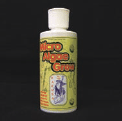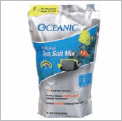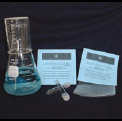Bioluminescent Algae
When you care enough to say it in glow-in-the-dark bacteria By Chris Quintero

Figure A: Stating the obvious
You may have memories of running after fireflies with outstretched hands on a warm summer evening. You may have even watched some Discovery Channel documentary on the mysteries of the deep sea and marveled at those “glowing” organisms found there. Chances are however, you probably haven’t heard too much about the plethora of bioluminescent creatures inhabiting this planet.
Bioluminescence (literally meaning “living light”) occurs within many living organisms, although most are relegated to the deep sea. This chemical reaction involves the oxidation of Luciferin (just a name for a class of biological light-emitting pigments). While related, the name doesn’t have devilish origins, but rather the same Latin origin “lucifer,” meaning “light bringer.”
Depending on the organism, the light can be used for camouflage, attraction, or even communication among bacteria, to name a few. Some of the more notable organisms that bioluminesce include fireflies, glow worms, bacterium, a plethora of marine life, and even mushrooms.
Today, we’ll focus on a particular light-emitting algae known as Pyrocystis fusiformis. These dinoflagellates typically do not occur in high enough concentrations among marine algae to produce a vary noticeable glow. However, when the conditions are right (excess nutrients, enough sunlight, etc.) an algal bloom can occur and populations will explode. Chances are, you’ve heard of this phenomenon before, known as a Red Tide.
1. Gather the materials
A number of marine enthusiasts already grow phytoplankton at home for use in feeding various species of marine life. The method we’ll use is similar.
To start, you’ll need:
![]() A clear growing container (e.g., old soda bottle)
A clear growing container (e.g., old soda bottle)
![]() Sea salt
Sea salt
![]() A grow light and timer
A grow light and timer
![]() Micro Algae Grow
Micro Algae Grow
![]() Optional: Small, motorized air pump
Optional: Small, motorized air pump
![]() A starter culture
A starter culture
Sea salt: No, not from your pantry, you gourmet fiend, you can get this at most pet or aquarium stores.
Grow light: You can pick up a plant fluorescent and rack from Wal-Mart for around $10. Make sure you have a light timer.
Micro Algae Grow: Our most crucial ingredient (besides the actual algae). There are a number of nutrient formulas people have experimented with, and truthfully, I’ve only had mixed results with this one. Experiment with what works best. You can get it here: http://tinyurl.com/3g2wdv.
Air pump: This is used to both circulate the nutrients and to keep vital CO2 in the water. The algae need this to grow.
A starter culture: These can be obtained from a few places online. I’ve used Sunnyside Sea Farms, http://tinyurl.com/451gel.
2. Preparation and mixing
Sanitation is necessary so your batch doesn’t crash. After you really wash out the soda bottle, make sure there is absolutely no residue left. Some people say swirl some diluted bleach around in the bottle. Others say to stick it in the microwave after it’s completely dry (won’t melt or deform if it’s dry… wet is another story). Choose your preference.
Additionally, sanitize the tubing if you’re using an air pump, and anything else you’re using to prepare this batch.
Figure B: A “Lights from the Sea” Pyrocystis fusiformis starter culture

Figure C: Micro Algae Grow, nutrient formula

Figure D: Sea salt, of the aquarium store variety

Figure E: A typical grower’s set-up
Mix up a batch of salt water. I’ve used purified water, however some people swear by tap water as it adds in some minerals needed for the algae to grow. I’m sure the composition of minerals in tap water varies significantly from region to region, so I’ll let you make that decision. For help, you can check out some of the discussions on the topic at http://tinyurl.com/53srjf.
Regardless, mix the salt to a 1.019 specific gravity (sg) concentration. Directions on how to do this are on the back of the package. You’ll need a hydrometer if you’ve never done this before.
Add in ~1 ml of the Micro Algae Grow. In this case, less is more. The solution you received the culture in should already have enough nutrients to support sizable growth. If you don’t want to mess with making your own solution (not necessarily a bad idea), many places that sell starter cultures will also sell culture solution.
Let both the solution and culture bag sit in the same area out of the sun for an hour or two. This is simply to let them reach room temperature. A sudden change in temp during transfer could shock the culture enough to significantly harm it. If your room temp is in the 70s, you should be okay. If my memory is correct, they grow ideally if the water temp is in the mid to upper 60s.
Finally, transfer the algae into your bottles. If you are using the air pump, be sure to cut a hole in the top of the bottle cap. When I say air pump, keep in mind I really only mean a few bubbles every 10-20 seconds or so. We don’t want to disturb these dinoflagellites too much—just resupply their CO2. I’ve even heard of people using another tank of yeast (which emit CO2) as their air supply. Figure E shows a typical grower’s setup. (Your bottles won’t be green, though.)
3. Growth
These dinoflagellates need a constant cycle of light and darkness for optimal growth. Put your grow light and bottles in a dark place (e.g., a closet) where you can strictly control how much light they get. Set the timer so the grow light is on a cycle of 12 hours on, 12 hours off. Don’t be worried if your starter culture doesn’t emit light right after you receive it. They will only bioluminesce in their night cycle, so plan the light cycles for when you want to see it.
Monitor your cultures for any sudden changes in color, and give them a gentle shake every day or so or all the sediment will collect to the bottom. If you have a successful culture, you will eventually need to “split” the batch. Mix up another batch of saltwater/nutrients, and halve your culture between the new bottles.
Remember, these cool creatures will only brightly flash when disturbed, but too much disturbance can both harm them and wear them out. They have a “recharge” time so to speak between disturbances for optimal performance.
If you’re looking for something that will constantly glow, you might want to check out bioluminescent bacterium instead. You can get some from Carolina Biological Supply. Culturing this is a rather different process, but you can find some guides on the Net. One bioluminescent strain is Vibrio fischeri. See here: http://tinyurl.com/3t2tx2.
Good luck and have fun!
Often seen with tools in hand, Chris Quintero is pursuing a B.S. in mechanical engineering at the Georgia Institute of Technology. In his spare time, he enjoys windsurfing, cycling, and the occasional unexpected explosion.


